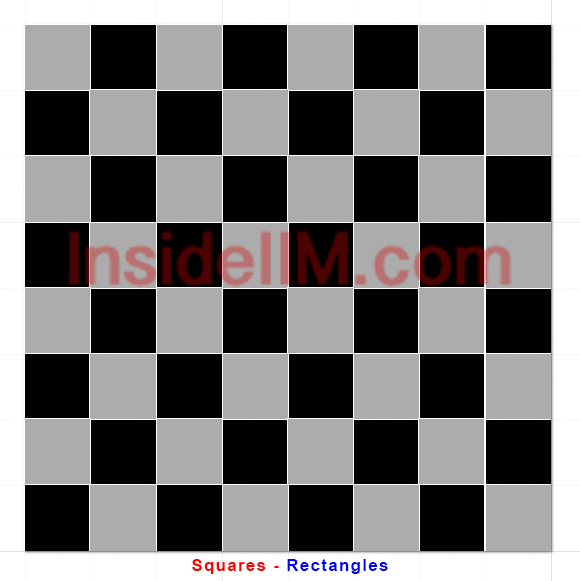Often times in CAT exam, questions are asked on "How Many Squares Are There In A Chessboard?" or "How Many Rectangles Are There In A 8*8 Chess-board Which Are Not Squares?", etc. These questions though look time confusing or difficult to some but are not if approached with right concept. Let's have a look at the same!
Formula: Number of squares in a n*n Chessboard: 12 +22 +....+ n2 or [n*(n+1)*(2n+1)]/6
In a 2*2 chessboard, there are 5 squares (4 small squares, 1 big square)
=> 12 +22 = 5
So in a 8*8 chessboard, n=8
=> No. of squares = 12 + 22 + 32+.....+ 82
= [n*(n+1)*(2n+1)]/6 (summation formula)
= 204
Also, number of white and black squares in chessboard: 204/2 => 102 each

Rectangles:
For an n*n chessboard, there are 13 + 23 + 33+.....+ n3 rectangles.
So for an 8*8 chessboard, there are, rectangles = 13 + 23+....+ 83
=> no. of rectangles = [{n2}*{(n+1)2}]/4
n=8, we get no. of rectangles = 1296
**No. of rectangles that are not squares in an 8*8 chessboard
=> 1296 - 204
= 1092
Likewise, it goes for 7*7, 6*6, 5*5, 4*4 or any other n*n matrix.
| Must Read: 15 Books to Read For CAT Preparation |
| Must Read: CAT Preparation Strategy By IIM A|B|C Convert |
Chess Arrangement Problems
Independence problems
Given a certain chess piece (queen, rook, bishop, knight or king) find the maximum number of such pieces, which can be placed on a chess board so that none of the pieces attack each other.
The maximum number of independent kings on an 8×8 chessboard is 16, queens - 8, rooks - 8, bishops - 14, knights - 32.
Domination problems
In these problems it is requested to find a minimum number of pieces of the given kind and place them on a chess board in such a way, that all free squares of the board are attacked by at least one piece.
The minimal number of dominating kings is 9, queens - 5, rooks - 8, bishops - 8, knights - 12.
What is the probability of getting two squares having a common side on a 8*8 chess board?
Method 1
No. of vertical lines in a chess board (not counting the external boundaries) is 7.
Each such vertical line is divided into 8 smaller parts.
Total no of such vertical smaller parts (vertical edges of small squares) = 8*7 => 56
Similarly, no of horizontal smaller edges = 56
total number of edges = 112.
Every single edge gives a unique combination of selecting squares that have a common edge.
Total number of ways of selecting two squares = 64C2.
Hence, probability = 112/64C2 = 0.0555
Method 2
There are three types of squares in a chess board.
Type 1: The four corners.
Type 2: The squares at the edges but not the corners = 24
Type 3: The squares which are not in the corners nor at the edge = 36
Type 1: For each square there are two possibilities. Total = 4*2 => 8
Type 2: For each square there are three possibilities. Total = 24*3 => 72
Type 3: For each square there are four possibilities. Total = 36*4 => 144
No of ways 1st square can be chosen = 64 ways.
no of ways 2nd one can be chosen = 63 ways.
Total = 64*63
Required Probability = 224/(64*63) = 0.055
If two squares are chosen at random on a chessboard, what is the probability that they have exactly one corner in common?
There are 3 types of squares, a different number of each type, and each with a different number of squares they share exactly one corner with:
- Corners - 4 of them-shares exactly 1 corner with 1 square.
- Edges - 24 of them-shares exactly 1 corner with 2 squares.
- Other - 36 of them-shares exactly 1 corner with 4 squares.
Type 1: 4*1=4
Type 2: 24*2=48
Type 3: 36*4=144
Total = 196
Total Ways of choosing any 2 squares one after another = 64*63
Hence, required probability = 196/(64*63) = 0.486
Method 3
In the first and second row, there are 14 ways of selecting two (1 x 1) squares that have only one common corner.
Rows 2 and 3 will similarly have 14 squares that have only one common corner.
We can pick 7 such pairs of rows in a chess board viz., (1, 2), (2, 3), (3, 4), (4, 5), (5, 6), (6, 7), and (7,8)
Also Check:
- CAT Preparation Tips & Strategy By Current MBA Students &Alumni
- CAT latest exam pattern, syllabus and other Quant concepts
